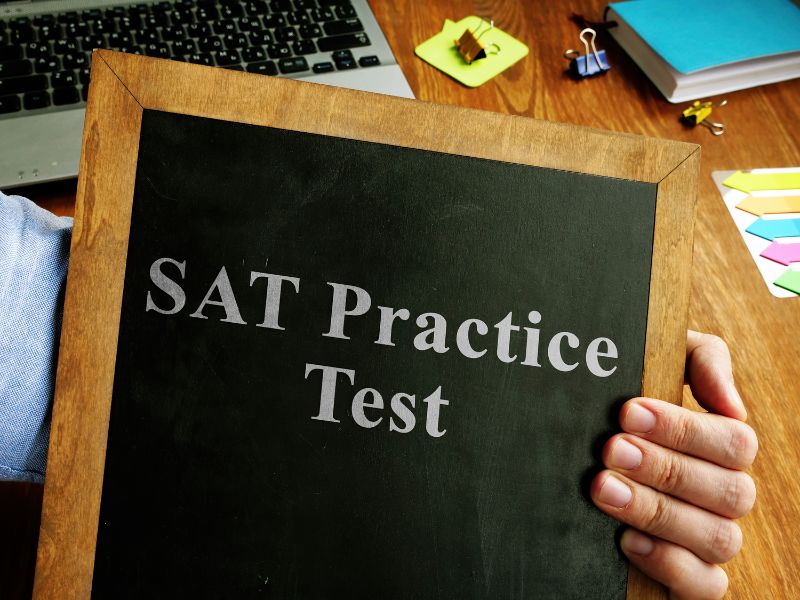SAT practice tests are integral to any ambitious student's preparation for this pivotal examination.

They are designed to replicate the actual SAT exam experience, helping students familiarize themselves with the structure, question types, and time constraints they'll encounter on test day. These simulations cover the same sections as the actual SAT – Reading, Writing and Language, Math, and an optional Essay portion.
However, it's worth noting that the value of these SAT practice tests extends beyond just an exercise in mimicry. They serve as an effective tool for identifying strengths and weaknesses, refining time management skills, and reducing exam anxiety through familiarity. In essence, these tests aim to bridge the gap between learning and assessment, providing a testing ground for students to put their knowledge into practice.
Overview of Actual SAT Tests
The SAT is a standardized test that forms a significant criterion for college admissions in the United States. It assesses students' readiness for college through three mandatory sections: Reading, Writing and Language, and Math. An optional Essay section is also included, required by some institutions.
The Reading section includes passage-based questions from various genres, the Writing and Language section tests grammatical proficiency and clarity of expression, and the Math section is split into two parts – one permitting the use of a calculator and the other not. These sections test rote learning and assess a student's ability to apply knowledge and reasoning skills.
Over the years, the SAT has seen minor and significant changes. These shifts, which could range from alterations in the scoring system to variations in question types, make it a dynamic test that evolves to assess college readiness better.
Comparative Analysis
When we compare SAT practice tests with the actual SAT, the first noticeable similarity is their structure. Both feature the same sections, are presented in the same order, and have nearly identical time limits. This structural alignment is no coincidence, as it aims to simulate the test environment as closely as possible.
However, there's more to this comparison than just surface-level similarities. Diving deeper, we find differences that can significantly impact a student's preparation strategy.
First, the nature of the questions can vary. While practice tests strive to mirror the type and style of questions on the SAT, they may not always accurately represent the nuances in question framing or the subtle shifts in difficulty level across different sections or tests. For example, a specific practice test might have a stronger emphasis on geometry in the Math section, while the actual SAT on the given test day may focus more on algebra or data analysis.
Second, the difficulty level can differ. The creators of practice tests endeavor to match the difficulty of the actual SAT, but achieving a perfect match can be challenging due to the confidential nature of test development and the SAT's changing trends. Students might find some practice tests harder or more accessible than the actual SAT.
These variations, among others, underscore the importance of using a range of practice tests from various sources better to cover the breadth and depth of potential SAT content.
In the following sections, we'll delve into how accurately SAT practice tests predict actual SAT scores and how students can improve the efficacy of their practice tests, taking into account these observed differences and similarities.
The Accuracy of Practice Tests
Practice tests are highly valuable as they are predictive of your SAT preparation. They help gauge a student's potential performance on the actual SAT by providing a rough estimation of their scores. However, their accuracy isn't foolproof. The predictive power of SAT practice tests can be influenced by several factors, including the source of the practice test, the conditions under which the test is taken, and how seriously the student approaches the practice test.
While practice tests often correlate with actual SAT performance, they may not account for variables like test-day nerves, fluctuations in health, or other unforeseen circumstances. Nonetheless, consistent scores on practice tests usually indicate that a student is likely to achieve a similar score range on the SAT, making them an indispensable tool for gauging progress and readiness.
Improving SAT Practice Test Efficacy
Despite differences between SAT practice tests and the actual SAT, they remain crucial in a student's SAT preparation arsenal. To improve their efficacy, here are a few tips:
-
Diversify your sources: Using practice tests from various reliable sources can help ensure more comprehensive coverage of potential SAT topics, question styles, and difficulty levels.
-
Replicate test conditions: Try to take the practice tests under conditions that mimic the actual test day. This includes timing yourself, taking only the allowed breaks, and removing potential distractions.
-
Analyze your performance: Reviewing your answers is crucial. Understand why you got specific questions wrong and note the areas that need improvement.
-
Consistency is vital: Regularly taking practice tests can build stamina and reduce test anxiety.
Remember, practice tests aim not to intimidate or overwhelm but to prepare and empower. With the right strategies, SAT practice tests can become a confidence-building step toward achieving your SAT goals.
Conclusion
In conclusion, while SAT practice tests may not perfectly mirror the actual SAT regarding question specifics and difficulty levels, they are an indispensable part of adequate SAT preparation. They serve as a mirror, reflecting your strengths and areas for improvement, and a crystal ball, offering a glimpse into your potential performance on the actual SAT. By understanding their role, benefits, and limitations, you can optimize their use in your journey toward SAT success.
